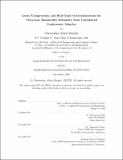Lossy compression and real-time geovisualization for ultra-low bandwidth telemetry from untethered underwater vehicles
Author(s)
Murphy, Christopher Alden
DownloadFull printable version (12.68Mb)
Other Contributors
Woods Hole Oceanographic Institution.
Advisor
Hanumant Singh.
Terms of use
Metadata
Show full item recordAbstract
Oceanographic applications of robotics are as varied as the undersea environment itself. As underwater robotics moves toward the study of dynamic processes with multiple vehicles, there is an increasing need to distill large volumes of data from underwater vehicles and deliver it quickly to human operators. While tethered robots are able to communicate data to surface observers instantly, communicating discoveries is more difficult for untethered vehicles. The ocean imposes severe limitations on wireless communications; light is quickly absorbed by seawater, and tradeoffs between frequency, bitrate and environmental effects result in data rates for acoustic modems that are routinely as low as tens of bits per second. These data rates usually limit telemetry to state and health information, to the exclusion of mission-specific science data. In this thesis, I present a system designed for communicating and presenting science telemetry from untethered underwater vehicles to surface observers. The system's goals are threefold: to aid human operators in understanding oceanographic processes, to enable human operators to play a role in adaptively responding to mission-specific data, and to accelerate mission planning from one vehicle dive to the next. The system uses standard lossy compression techniques to lower required data rates to those supported by commercially available acoustic modems (O(10) - O(100) bits per second). (cont.) As part of the system, a method for compressing time-series science data based upon the Discrete Wavelet Transform (DWT) is explained, a number of low-bitrate image compression techniques are compared, and a novel user interface for reviewing transmitted telemetry is presented. Each component is motivated by science data from a variety of actual Autonomous Underwater Vehicle (AUV) missions performed in the last year.
Description
Thesis (S.M.)--Joint Program in Applied Ocean Science and Engineering (Massachusetts Institute of Technology, Dept. of Electrical Engineering and Computer Science; and the Woods Hole Oceanographic Institution), 2008. This electronic version was submitted by the student author. The certified thesis is available in the Institute Archives and Special Collections. Includes bibliographical references (p. 79-83).
Date issued
2008Department
Joint Program in Applied Ocean Physics and Engineering; Woods Hole Oceanographic Institution; Massachusetts Institute of Technology. Department of Electrical Engineering and Computer SciencePublisher
Massachusetts Institute of Technology
Keywords
/Woods Hole Oceanographic Institution. Joint Program in Applied Ocean Science and Engineering., Electrical Engineering and Computer Science., Woods Hole Oceanographic Institution.